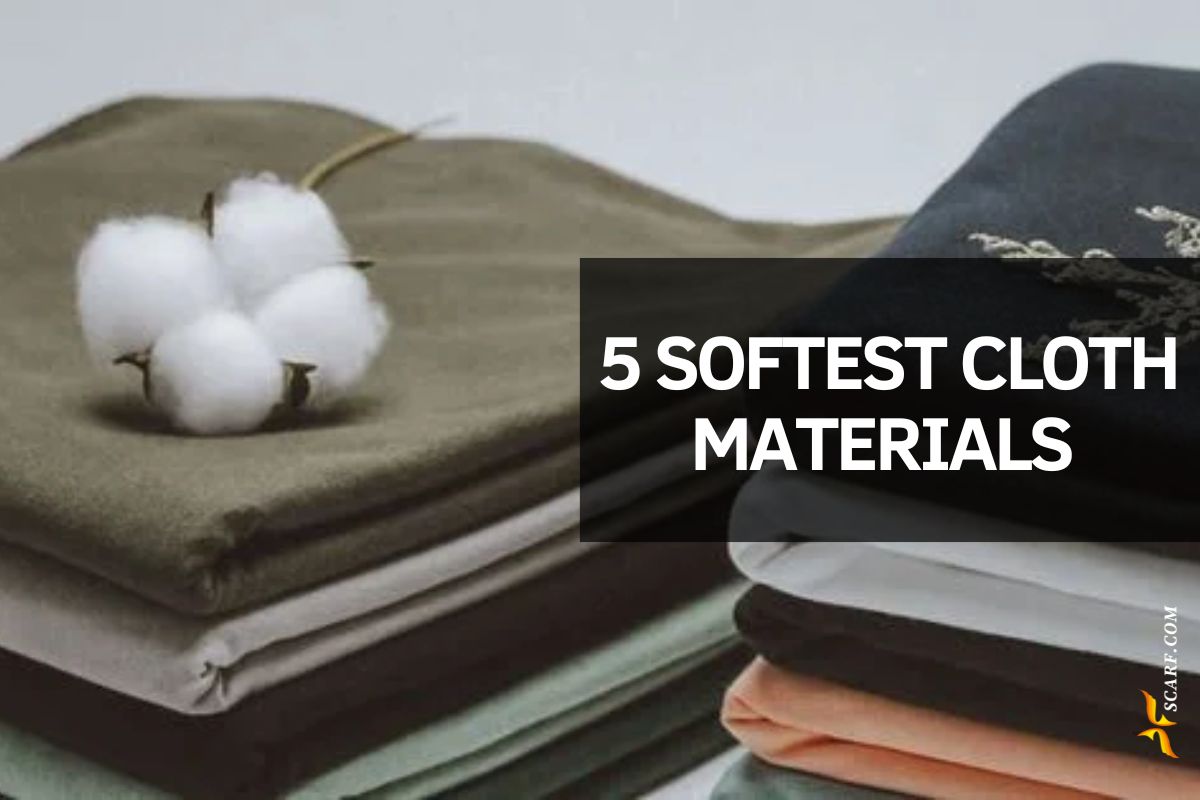Whether it’s a cozy sweater, delicate sleepwear, or your favorite t-shirt, the right material transforms how you feel.
With countless options available, knowing which textiles offer true softness can be challenging. This guide introduces five remarkably softest cloth materials. It will help you understand their unique qualities and select what suits you best.
Short answer
The top five softest cloth materials for your skin are silk, high-thread-count cotton, cashmere, bamboo viscose, and microfiber. Each offers a unique type of softness, from the smooth glide of silk to the cozy warmth of cashmere.
- Short answer
- What Makes a Fabric Soft?
- Top 5 Softest Cloth Materials
- Caring for Soft Fabrics
- Selecting Your Ideal Soft Fabric
- FAQ
- 1. Which is softer: cotton or bamboo?
- 2. What is the world’s softest fabric?
- 3. Can synthetic fabrics be as soft as natural ones?
- 4. Why is cashmere so expensive?
- 5. How can I make my clothes softer?
- 6. Is silk softer than satin?
- 7. What is the softest cotton?
- 8. Can a fabric be too soft?
- 9. What is the softest blanket material?
- 10. Which soft fabrics are hypoallergenic?
What Makes a Fabric Soft?
Multiple elements contribute to a fabric’s softness.
- Fiber Type: Natural fibers like cotton, silk, and cashmere are celebrated for their inherent softness. Some synthetic fibers such as microfiber polyester are also engineered for supreme softness.
- Fiber Fineness: Thin, fine fibers—like those in high-grade cotton or microfiber—create smoother, softer textures.
- Fabric Structure: The weave or knit affects softness. Looser constructions often feel more pliable and gentle against the skin.
- Special Treatments: Processes like brushing, enzyme-washing, or pre-softening enhance texture and comfort.
Personal sensitivity plays a role. The softest cloth material differs from person to person.
Top 5 Softest Cloth Materials
Explore these five exceptionally soft fabrics perfect for sensitive skin.
1. Silk: Luxurious Smoothness
Silk, a natural protein fiber, offers a smooth and lustrous feel. It is lightweight and wonderfully gentle.
- Why it feels soft: Its fibers are extremely fine and sleek. This creates low friction and a delicate touch.
- Ideal uses: Pajamas, lingerie, blouses, and decorative linings. Its cooling property suits warm climates.
- Considerations: Silk demands careful maintenance. Hand wash or dry clean recommended. It is also a higher-priced material.
2. High-Thread-Count Cotton: Timeless Comfort
Cotton is a classic favorite. Superior varieties like Egyptian or Pima cotton offer exceptional softness and breathability.
- Why it feels soft: Long-staple fibers spin into fine, strong yarns. High thread count weaves yield a smooth, dense, and soft fabric.
- Ideal uses: Bedding, t-shirts, bath towels, and daily casual wear. Perfect for those who value natural fibers.
- Considerations: Can wrinkle easily. May shrink if machine-dried with high heat. Quality varies widely.
3. Cashmere: Lightweight Warmth
Cashmere, sourced from goat undercoats, is uniquely soft, light, and insulating. It feels luxurious and cozy.
- Why it feels soft: Its fibers are finer and softer than sheep’s wool. The scaled structure avoids prickliness, offering cloud-like comfort.
- Ideal uses: Premium sweaters, scarves, winter accessories. Ideal for elegant, warm layers.
- Considerations: Requires gentle handling—hand washing is best. Prone to pilling. Higher cost reflects its rarity.
4. Bamboo Viscose: Silky and Sustainable
Bamboo-based fabric is a regenerated cellulose material. It is silky, drapes beautifully, and feels soft from the first touch.
- Why it feels soft: The fibers are naturally round and smooth. Many experience it as hypoallergenic and kind to sensitive skin.
- Ideal uses: Underwear, socks, breathable loungewear, and bedding. Great for moisture-wicking in activewear.
- Considerations: Check sourcing for eco-friendly credentials. Wrinkles more than cotton. Durability varies.
5. Microfiber: Engineered Softness
Microfiber refers to ultra-fine synthetic fibers, typically polyester. These are woven into plush, velvety-soft textiles.
- Why it feels soft: Extremely thin fibers are tightly woven or brushed. This creates a dense, nap-like surface that feels soft and plush.
- Ideal uses: Athletic wear, cleaning cloths, blankets, and upholstery. Valued for durability and stain resistance.
- Considerations: Less breathable than natural materials. May generate static. Not biodegradable.
| Fabric | Softness Feature | Best Uses | Care Needed |
|---|---|---|---|
| Silk | Smooth, luxurious | Sleepwear, formal wear | Delicate (hand wash/dry clean) |
| Cotton | Breathable, natural softness | Daywear, bedding, towels | Machine washable |
| Cashmere | Plush, lightweight warmth | Sweaters, winter accessories | Hand wash, flat dry |
| Bamboo Viscose | Silky, draping softness | Underwear, summer wear | Gentle machine wash |
| Microfiber | Dense, velvety texture | Sportswear, home textiles | Easy machine wash |
Caring for Soft Fabrics
Maintaining softness requires thoughtful care.
- Follow Care Labels: Always observe manufacturer instructions.
- Wash with Care: Use cold water and gentle cycles. Hot water may damage fibers.
- Choose Mild Detergents: Harsh chemicals can degrade fibers and reduce softness.
- Limit Softeners: Sometimes softeners coat fibers, reducing absorbency. For wool or silk, use specialized detergents.
- Dry Gently: Air-drying is safest. Tumble dry only on low.
- Store Correctly: Fold knits to avoid stretching. Keep natural fibers in dry conditions.
Selecting Your Ideal Soft Fabric
Your perfect softest cloth material depends on use, care commitment, and personal taste. Seek cotton for everyday ease, cashmere for luxury warmth, silk for elegant smoothness, bamboo for eco-conscious choices, or microfiber for modern performance.
Touch fabrics when you shop. Notice weight, texture, and response to skin. Enjoy discovering what brings you comfort and joy.
FAQ
1. Which is softer: cotton or bamboo?
Bamboo viscose often feels silkier initially. Cotton softens gradually over washes and offers reliable breathability.
2. What is the world’s softest fabric?
Fine cashmere and rare vicuña wool are among the softest due to their ultra-fine fibers.
3. Can synthetic fabrics be as soft as natural ones?
Yes. Advanced microfiber textiles match the softness of many natural materials.
4. Why is cashmere so expensive?
It comes from limited sources. Harvesting and processing are labor-intensive, justifying its premium cost.
5. How can I make my clothes softer?
Wash in cold water with mild detergent. Occasionally use vinegar in the rinse cycle. Avoid high-heat drying.
6. Is silk softer than satin?
Silk is a fiber; satin is a weave. Silk satin is generally softer and more luxurious than synthetic satin.
7. What is the softest cotton?
Egyptian and Pima cotton are top varieties known for long, silky-staple fibers.
8. Can a fabric be too soft?
Rarely. Some may find certain textures too slick or too fluffy for their preference.
9. What is the softest blanket material?
Fleece, soft wool, cashmere, and brushed cotton make wonderfully soft blankets.
10. Which soft fabrics are hypoallergenic?
Bamboo, silk, and high-quality cotton are often suitable for sensitive skin.
We specialize in customizing scarves, hats, clothing and accessories. Please feel free to contact us.



